VISIT TO THE DUOMO OF PORTOGRUARO

- The audio guide opens directly on the map of the Duomo. The numbers correspond to the position of the works in the church.
 Clicking on the map number takes you to the
contents of the work, the audio is indicated with a mobile phone icon with headset. If clicking on the
map number does not work, enlarge the map with thumb and index finger.
Clicking on the map number takes you to the
contents of the work, the audio is indicated with a mobile phone icon with headset. If clicking on the
map number does not work, enlarge the map with thumb and index finger. To listen to the audio, click on
the play button of the audio control.
To listen to the audio, click on
the play button of the audio control.  In the bottom right-hand corner there is a
red button that takes you back to the map.
In the bottom right-hand corner there is a
red button that takes you back to the map. The works with audio, except for the
presbytery, are indicated by a tag placed near the work and bearing the same number as the map and the
relevant QR code.
The works with audio, except for the
presbytery, are indicated by a tag placed near the work and bearing the same number as the map and the
relevant QR code.


 At the top of the page there are four flags
linked to the relevant languages. In addition, under the title of each work, the four flags allow you
to link to the same work in the other languages.
At the top of the page there are four flags
linked to the relevant languages. In addition, under the title of each work, the four flags allow you
to link to the same work in the other languages.- For some works there are in-depth areas.
- Starting from the first altar of the right-hand nave "Incredulity of St. Thomas", the numbers are sequential and follow the entire inner perimeter of the Duomo: right aisle, apse, left aisle and counter-façade.
- Warning! Please use earphones so as not to disturb those praying. If you do not have earphones, turn the volume down to the level of a normal telephone call and listen to the audio guide with the device held to your ear. Thank you

The Duomo of St. Andrew the Apostle in Portogruaro: a must-see and one of the most splendid settings to experience more than four centuries of spirituality, history, art and culture in the area. The purpose of this short guide is to welcome visitors to the Duomo and give them simple and concise information in order to enjoy the beauty expressed in the mainly pictorial art embellishing this place of worship.
Its consecration, on 4 August 1833 by the diocesan bishop Monsignor Carlo Fontanini, came forty years after Bishop Bressa laid the first stone, on 4 August 1793, and after a long period during which work on the building had stopped. The Duomo stands on the same spot as the earlier Church of St. Andrew, whose entrance was exactly opposite to the present one; the old church, in perilous conditions and in need of extensive renovations was demolished, particularly being now too small for regular religious services.
The original design was by Pietro Bettini (1740-1821), later revised by Father Buratti and completed by Antonio De Marchi (1781-1867). Some of the material used for its construction was taken from other churches that had been demolished: the Oratory of the Holy Spirit, St. Gotthard, St. James and, in 1830, the Church of St. Francis.
The Duomo's interior extends 53 metres in length, 20 metres of which is the presbytery; the transept is 29 metres wide and the central dome 24 metres high; the height of the nave is 19 metres and that of the side aisles 11 metres.
1586 to 1974, the diocesan bishop resided in Portogruaro, with the Duomo serving as an auxiliary or co-cathedral church. In 1974, Bishop Abramo Freschi moved the bishopric to Pordenone, hence the name of the diocese "Concordia-Pordenone". The Duomo of St. Mark in Pordenone now serves as the co-cathedral church.
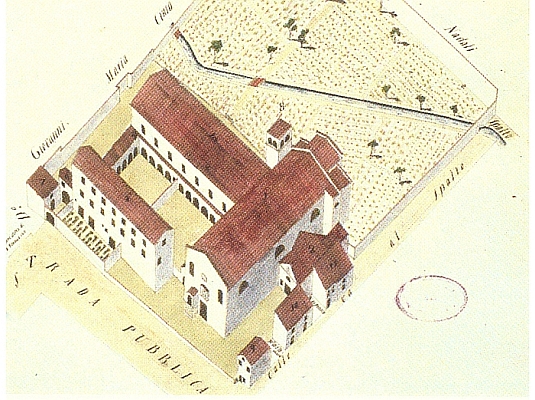
Church and convent of St Francis demolished in 1830
This guide will help you discover important works of art originating from the old parish church, the Church of St. Francis and from Napoleonic requisitions. It describes thirty-three points of interest, exploring the beauty of God and man, interpreted by the hand of great artists and sculptors from the Veneto-Friuli school.
Recently, there have been a number of important restorations: the 5 panels depicting scenes from the
life of St. Andrew by Pomponio Amalteo in 2006, The Last Supper by Sante Peranda in 2007, the
Crucifixion by Palma il Giovane in 2009, the radical overhaul of the Organ, The Presentation of Jesus in
the Temple by Giovanni Martini, and last but not least, the restoration in 2017 of the 14th-century
wooden Crucifix by an unknown artist but of considerable artistic interest.
All these restorations were possible thanks to the energy and determination of my predecessor Monsignor
Pietro Cesco
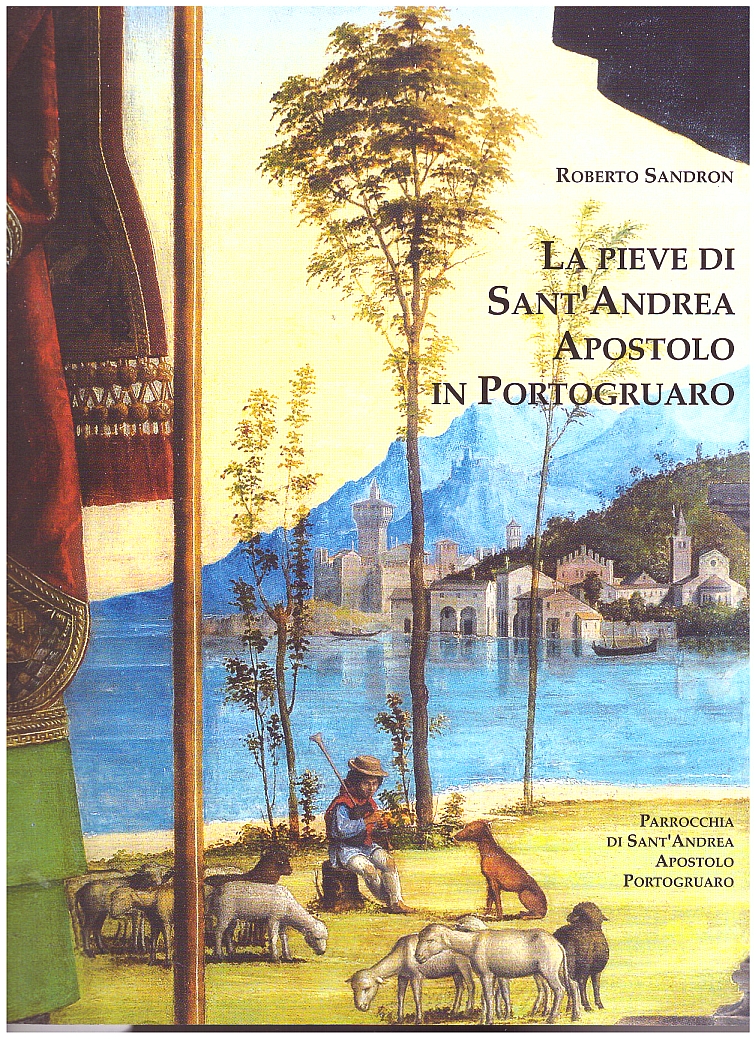
Anyone wishing to learn more about the Duomo's history can ask the parish for a copy of the excellent
book by Roberto Sandron entitled La pieve di Sant'Andrea Apostolo in Portogruaro.
We warmly welcome readers and visitors to the Duomo and the town of Portogruaro, wishing them a pleasant
and enjoyable stay.
The Parish Priest Monsignor Giuseppe Grillo.
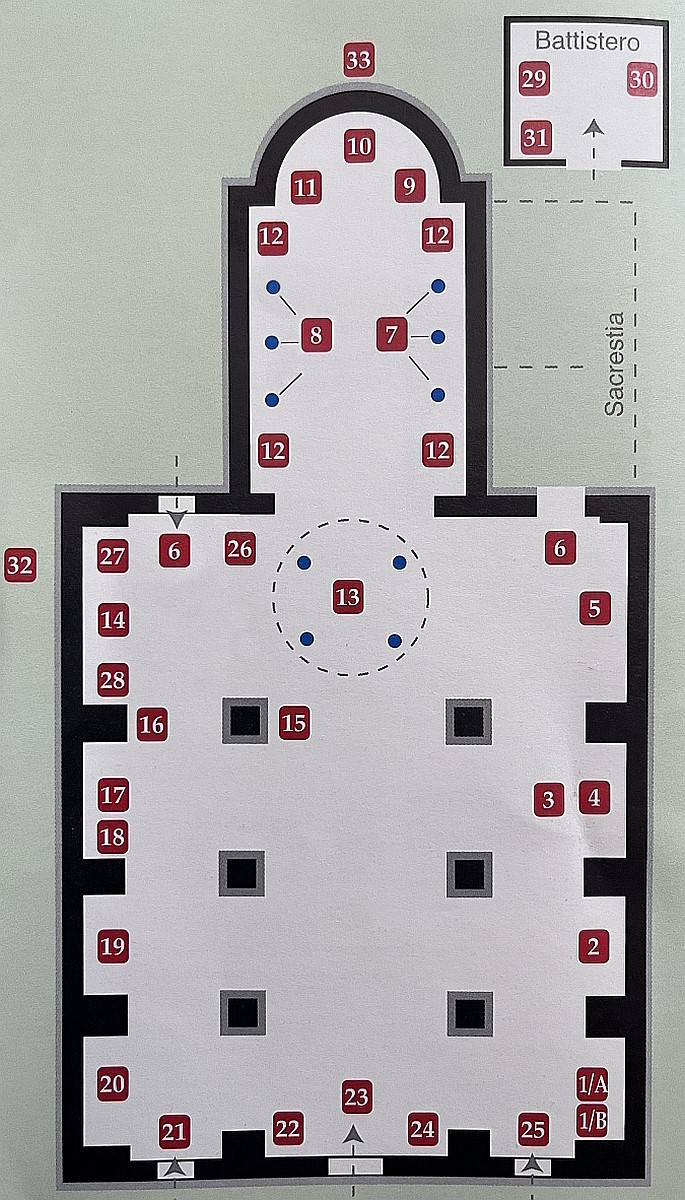
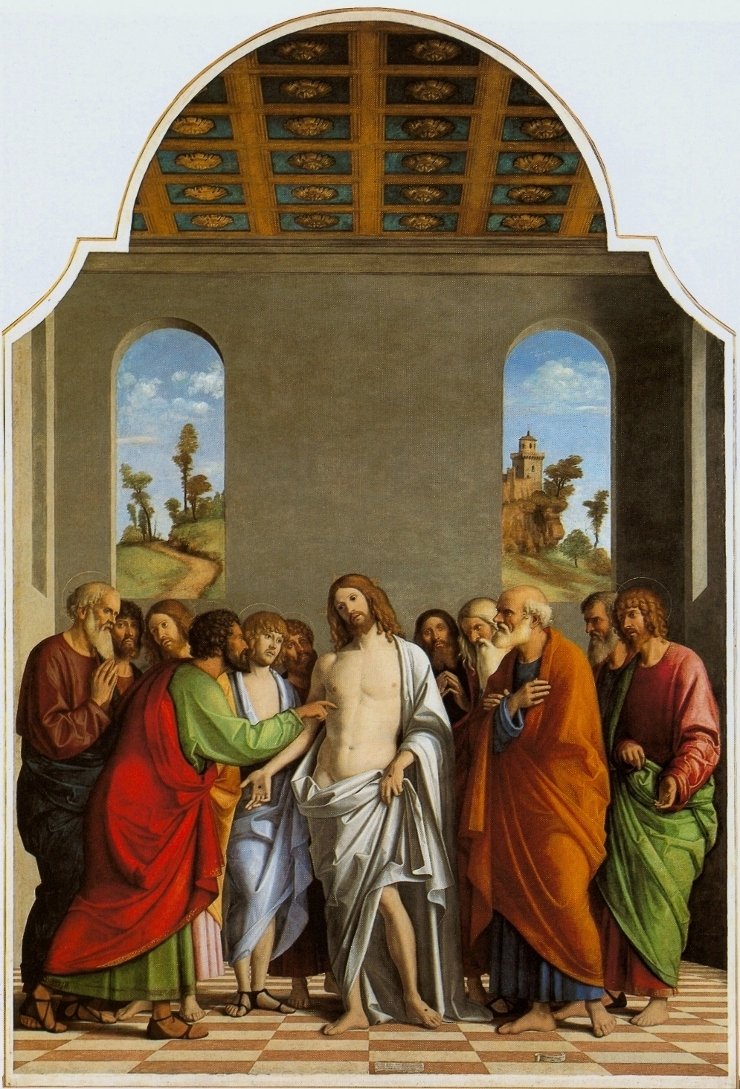

1.A - "Incredulity of St. Thomas" by Eugenio Bonò (Portogruaro 1806-1893), measuring: 3.90 by 2.10
metres.
It is a copy of the painting of the same name by Cima da Conegliano and was commissioned on occasion of the sale of the original to the National Gallery in London in 1871.
Giovanni Battista Cima da Conegliano, who was born in 1459 and died in 1517, had painted the original work for the Church of St. Francis in 1504.
Description...
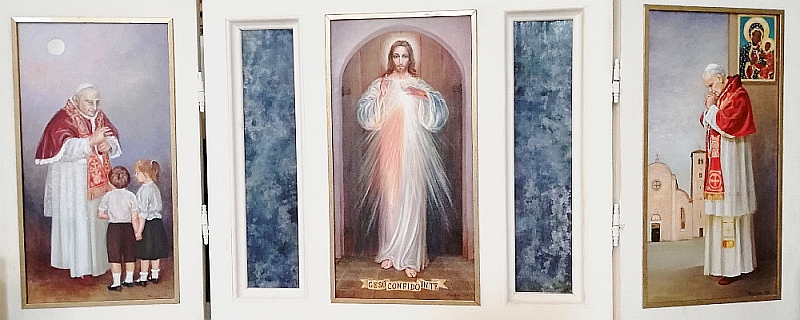
Margherita Albertario Fasoli, "Merciful Jesus with St. John XXIII and St. John Paul II", oil on canvas, 2011, 193x67 cm.
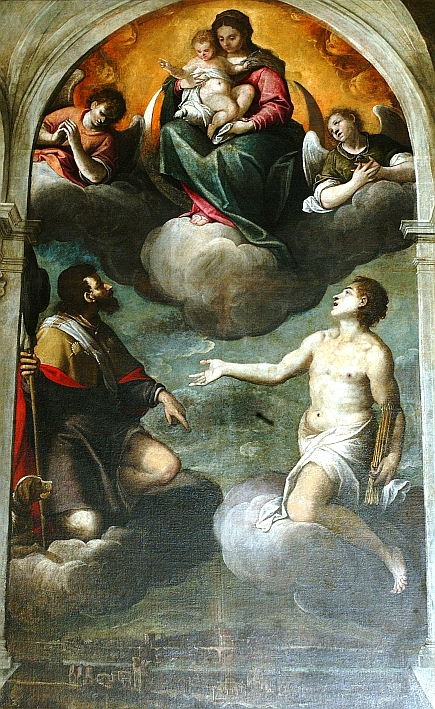


"Madonna and Child with St. Roch and St. Sebastian interceding for the town of Portogruaro" - from the School
of Palma the Younger, first half of the 17th century, dimensions 3 by 2 metres. Jacopo Negretti known as Palma the Younger lived in Venice between 1544 and 1628.
The painting was originally commissioned for the old St. Andrew's Church, which was demolished in 1793. The famous view of Portogruaro depicted in many later prints is taken from this altarpiece.
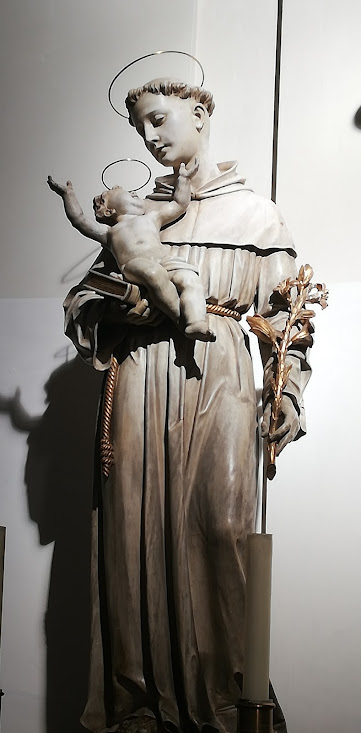

"St. Anthony". by Valentino Panciera known as Besarel (Astragàl di Zoldo 1829 - Venice 1902), a wooden sculpture from around 1901, approximately 1.30 metres high.
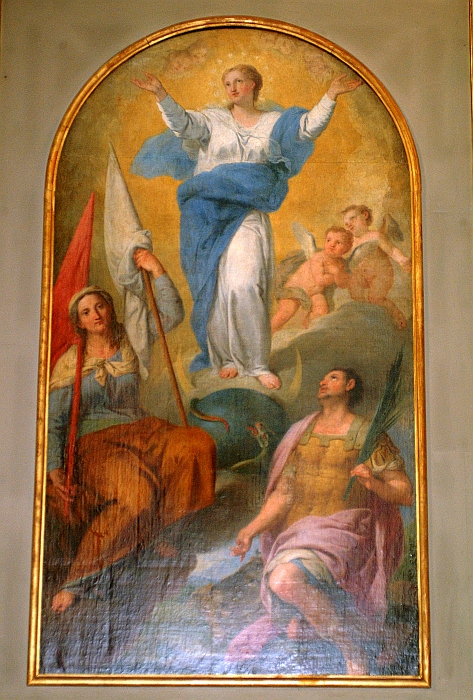

4 'Immaculate Conception with St. Anne and St. Florian' by Gregorio Lazzarini, who lived in Venice from 1665 to 1730. The painting dated 1718, measures 3.25 metres by 1.50 metres. It was originally commissioned for the Church of St. Francis demolished in 1830.
Description
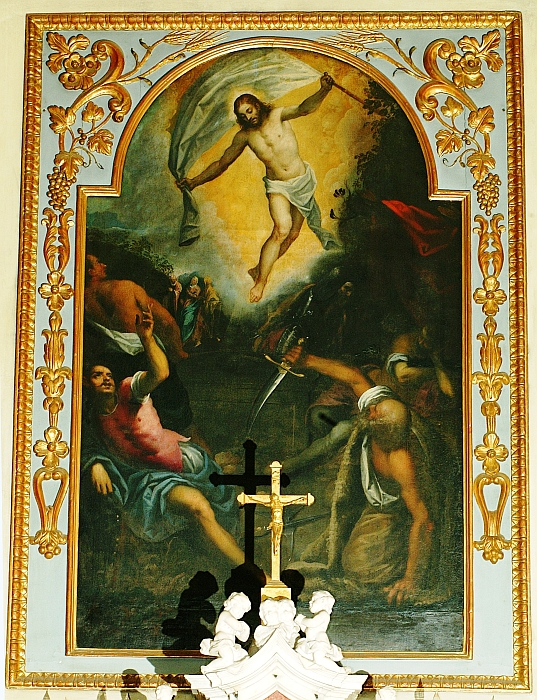

"Resurrection of Christ". by the School of Palma the Younger, dated late 16th century, and measuring 2 by 1.40 metres. Jacopo Negretti known as Palma the Younger lived in Venice between 1544 and 1628. The painting was originally commissioned for the old St. Andrew's Church.
Description...


6.2 "Angels holding a Eucharistic symbol", fresco in the lunette at the end of the right aisle by Tiburzio Donadon born in Motta di Livenza in 1881 and died in Pordenone in 1961. The work was painted between 1923 and 1925. The fresco 'Madonna della Salute' in the lunette at the end of the left aisle is by the same painter.
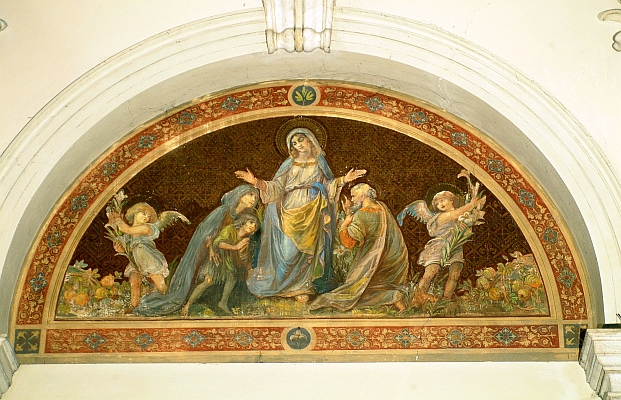
6.1 "Madonna della Salute", translated literaly means; "Our Lady of the Health" by Tiburzio Donadon..
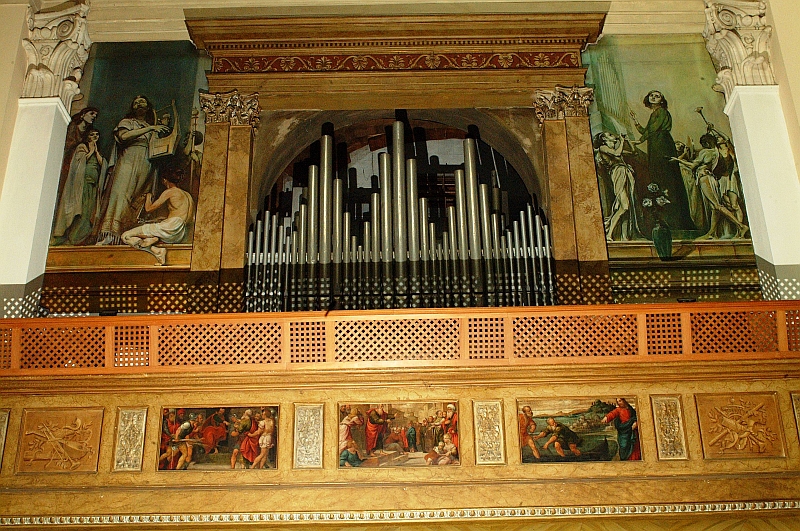
Choir loft on the right side
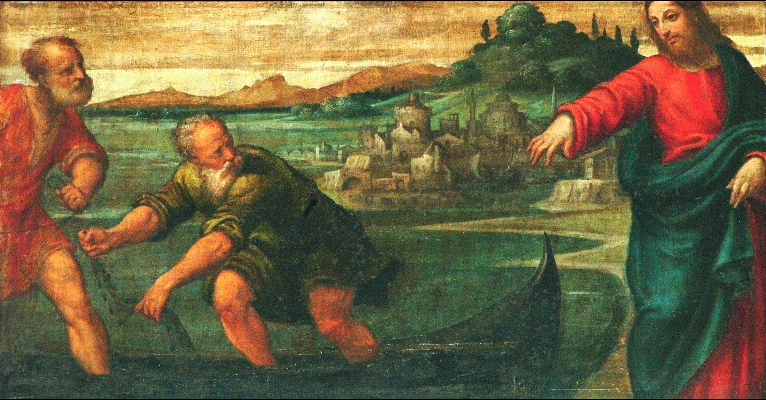
Pomponio Amalteo - The Vocation
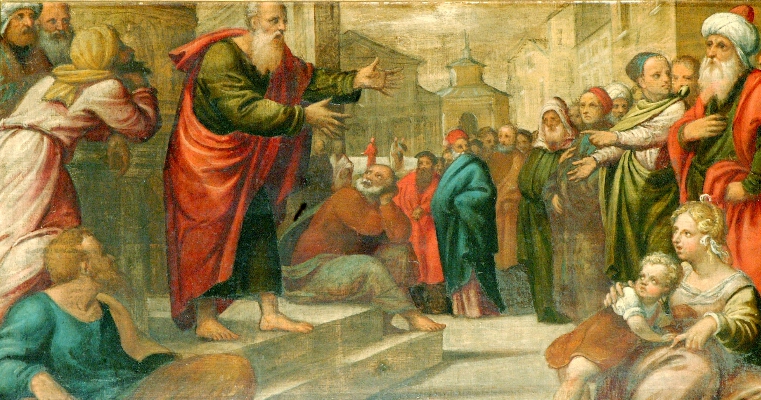
Pomponio Amalteo - The Preaching
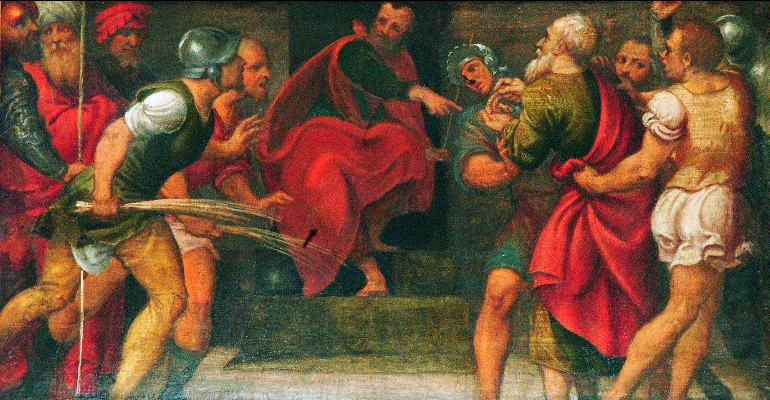
Pomponio Amalteo - The Condemnation

7 - Scenes from the life of St. Andrew, Patron saint of the town of Portogruaro: Three panels by Pomponio Amalteo, who was born in Motta di Livenza in 1505 and died in San Vito al Tagliamento in 1588. The panels are mounted in the balustrade of the right-hand choir loft and represent: "The Vocation", "The Preaching" and "The Condemnation", dated 1546. The panels each measuring 60 by 112 centimetres, were restored in 2006.
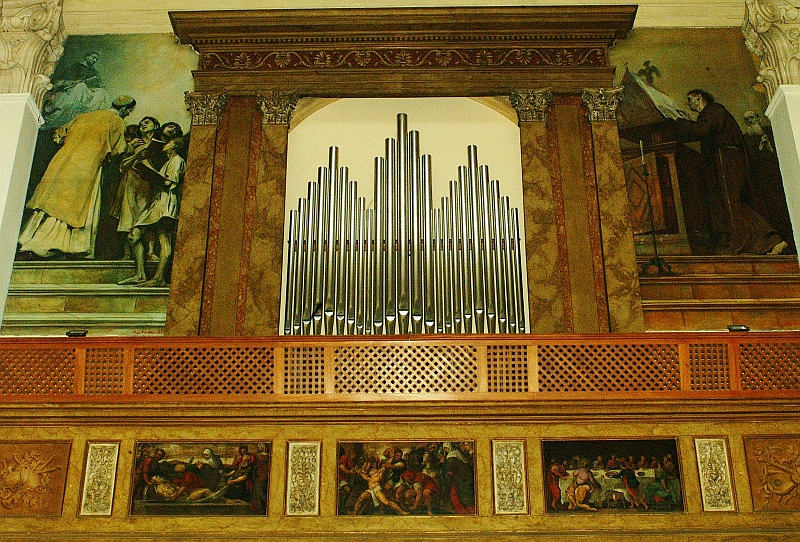
Left Choir Loft of the apse
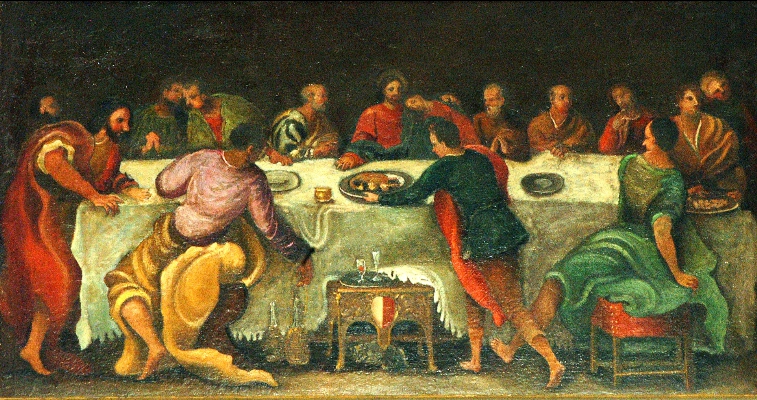
Unknown - Last Supper
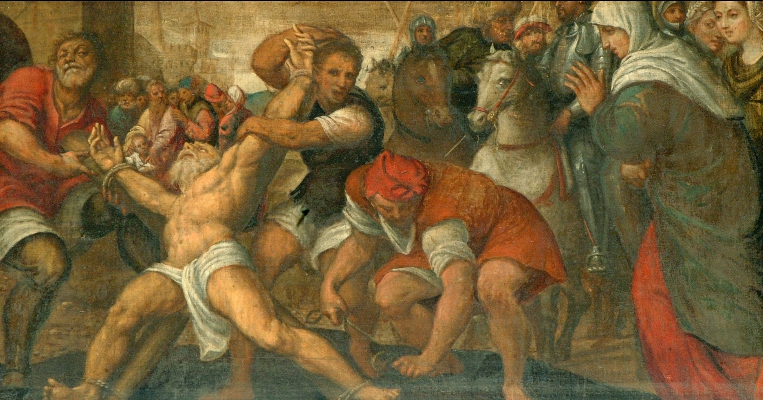
Pomponio Amalteo - The Crucifixion”
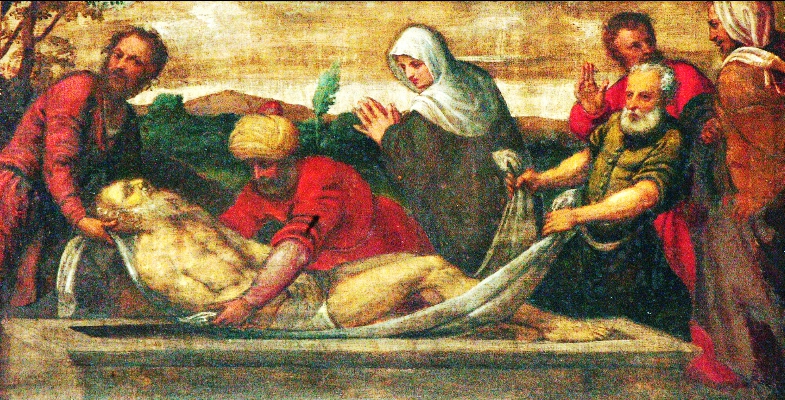
Pomponio Amalteo - The Burial

8 - Two panels by Pomponio Amalteo, who was born in Motta di Livenza in 1505 and died in San Vito al Tagliamento in 1588. The panels are mounted in the balustrade of the left choir loft and represent "The Crucifixion" and "The Burial", dated 1546. A third panel depincting the "Last Supper" by an unknown artist, and is undated. The panels, each measuring 60 by 112 centimetres, were restored in 2006.


9 "The Fall of Saul". by an unknown artist from the 16th century. It shows similarities with the
painting of the same subject by Nicolò Dell'Abate in the Kunsthistorisches Museum in Vienna,
but this is not sufficient evidence for an attribution or for a definite date. The painting was originally located in the old St. Andrew’s Church.
Description…
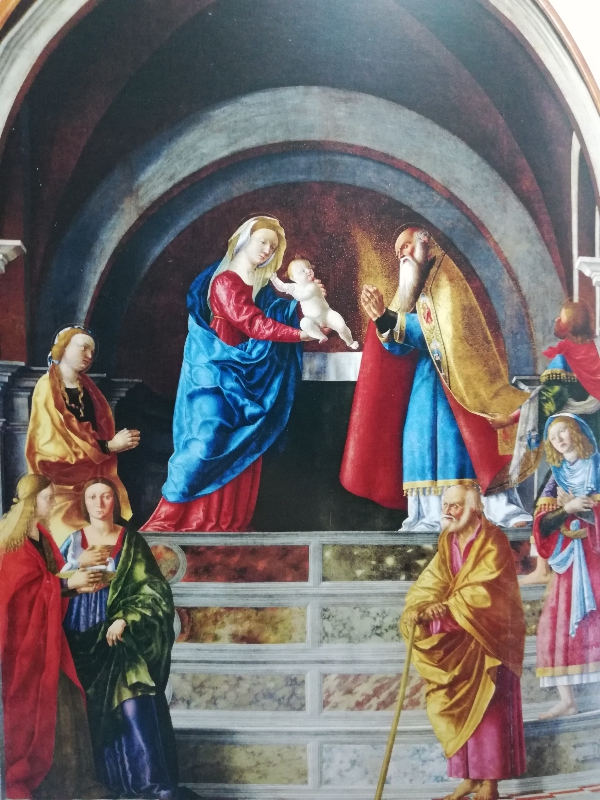

"The Presentation of Jesus in the Temple" by Giovanni Martini.
The painter was probably born in Tolmezzo around 1455 and died in Udine in 1535.
The work was painted for the altar of the Brotherhood of the Ceriola in the old
St. Andrew's Church and was installed on 2 February 1513. The painting was restored in 2009.
Description...
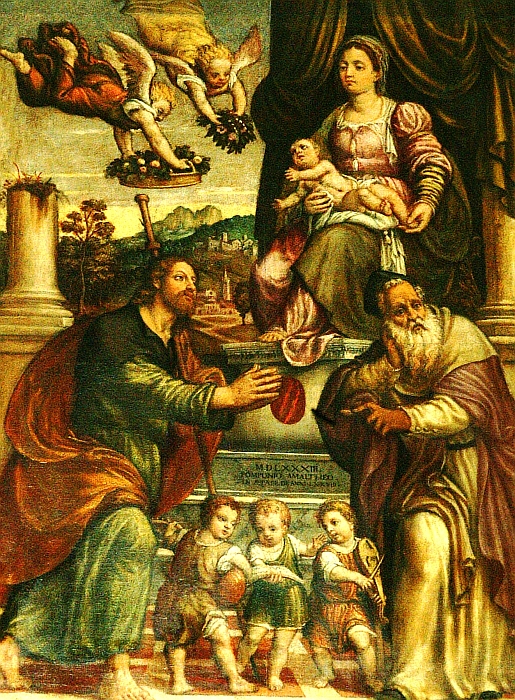

"Virgin and Child with St. James the Apostle and St. Anthony Abbot" by Pomponio Amalteo
(Motta di Livenza 1505 - San Vito al Tagliamento 1588). The painting, dated 1583
and measuring 220 by 150 centimetres, was commissioned for the old St. Andrew's Church.
Description...

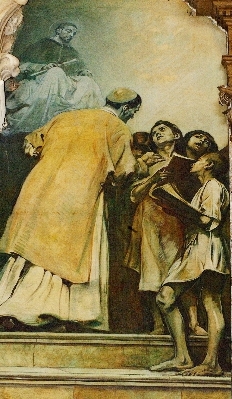
St Gregory the Great
reformer of sacred music
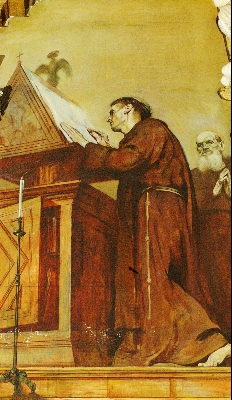
Guido D'Arezzo
dictating the musical notes

THE GREATS IN SACRED MUSIC, Pope Gregorio Magno and Guido d’Arezzo. Opposite the organ, in the left choir loft, there are two of the four paintings by Umberto Martina, who lived in the province of Pordenone between 1880 and 1945. Each canvas measures 400 by 180 centimetres: on the left 'Pope Gregory reformer of sacred music' and, on the right, 'Guido D'Arezzo dictating musical notes'. Both canvases painted in 1934.


King David
sings the Lord's praises
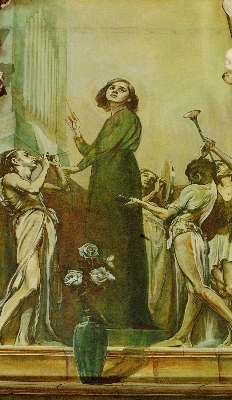
S. Cecilia,
patron saint of musicians

History of Music, four canvases by Umberto Martina born in Dardago, Pordenone in 1880 and died in Tauriano, also in the province of Pordenone, in 1945. Each canvas measures 400 by 180 centimetres. In the right choir loft next to the organ: 'King David singing the praises of the Lord' on the left and 'St. Cecilia, patron saint of musicians' on the right. Both canvases were painted in 1934.
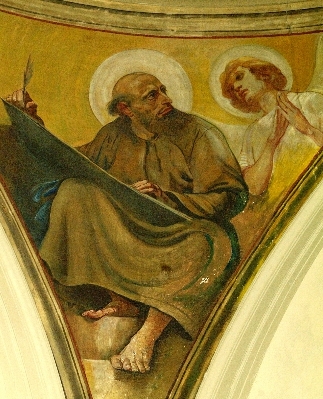
St. Matthew
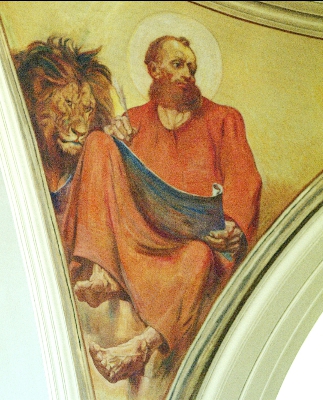
Saint Mark
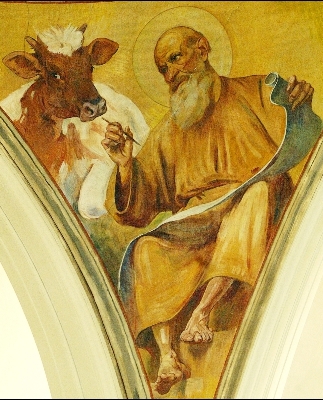
St. Luke
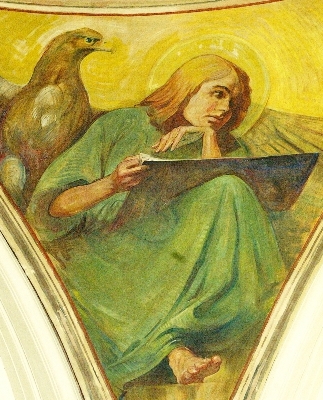
Saint John the Evangelist

Four frescoes with the Evangelists on the spandrels of the dome were painted in 1934 by Umberto Martina, who lived in the province of Pordenone between 1880 and 1945. Each evangelist is accompanied by his identifying symbol: St. Matthew and the human figure - St. Luke and the bull - St. Mark and the lion - St. John the Evangelist and the eagle.
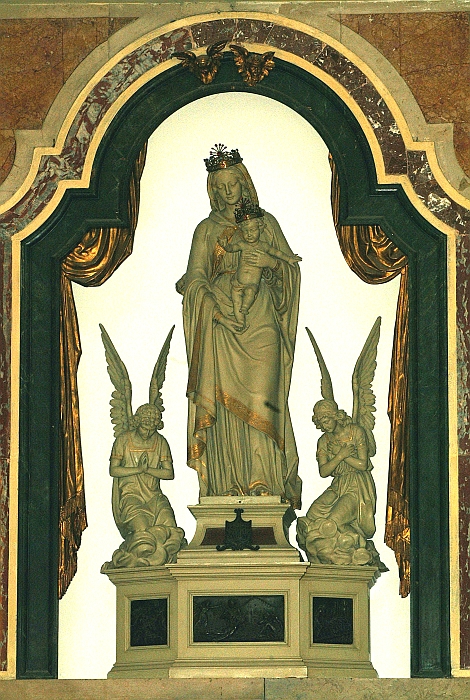
"Group of Our Lady of Health and Angels" by Valentino Panciera known as Besarel (Astragàl di Zoldo 1829 - Venice 1902), wooden sculpture dated 1893, 170 cm high.
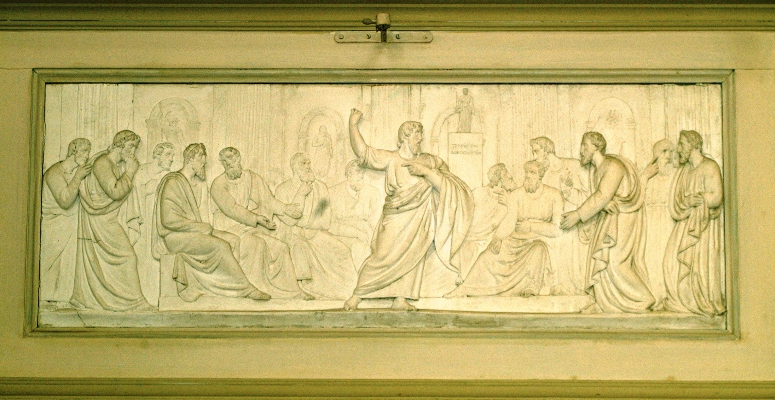

Three stucco and plaster panels on the pulpit balustrade by Antonio Marsure (Pordenone 1807 - Udine 1855), depicting scenes from the life of St. Andrew, dated around 1831: " Profession of Faith", 103x56 cm, "Preaching", 160x56 cm, "Salute to the Cross of Martyrdom", 103x56 cm.
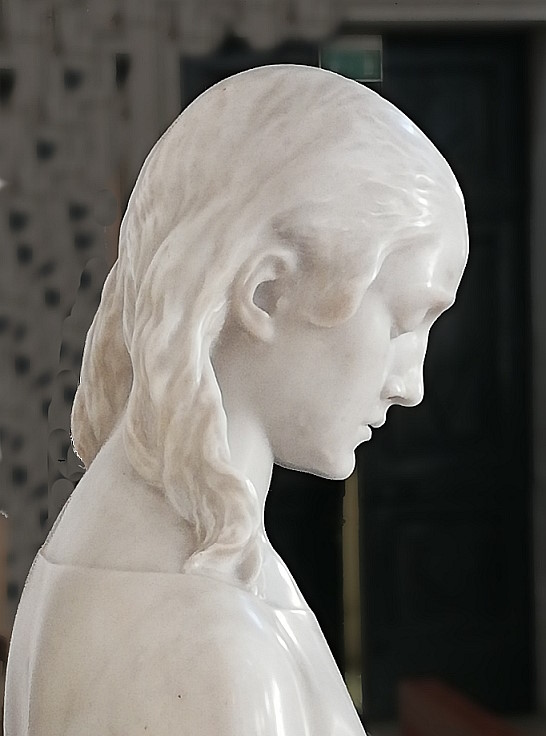

“ANNUNCIATION” by the sculptor Arrigo Minerbi from the important city of Ferrara (1881-1960), with an inscription by Giovanni Costanzi, dated around 1930. The work was donated to the Duomo by the Marzotto family in memory of Annalisa, who suffered from cystic fibrosis and died prematurely at the age of 32. She was the daughter of Marta and Umberto Marzotto.
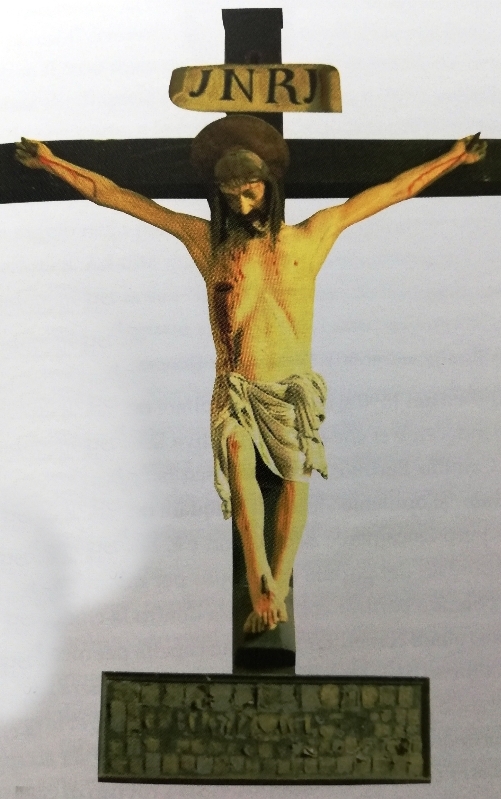
The Crucifix before the restoration
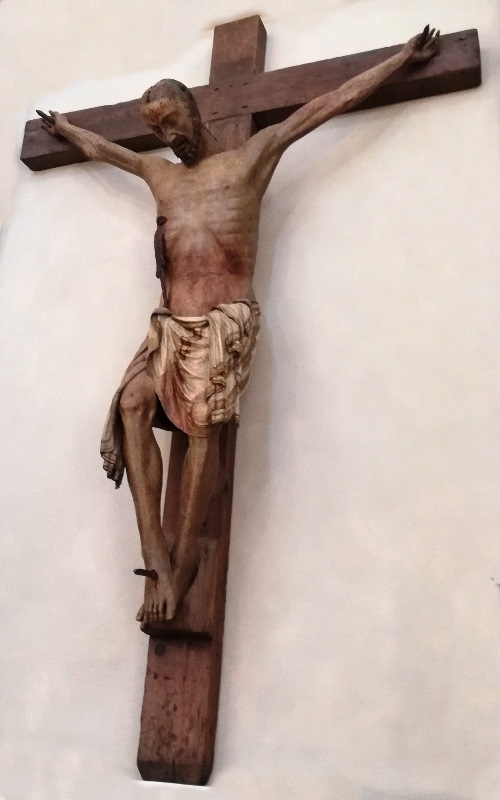
Crucifix after the restoration

17- "Crucifix", in poplar wood by an unknown artist, 14th century, and measuring 186 x 182 cm (including the cross 298 x 190 cm). It was restored in 2017 by Giovanni Magri with the support of the "Associazione Accordi" and "Fondazione S. Stefano". The unexpected and remarkable stylistic innovations emerging from the restoration call for an in-depth study of the work that, in any case, already stood as an important landmark in the field of 14th-century sculpture.
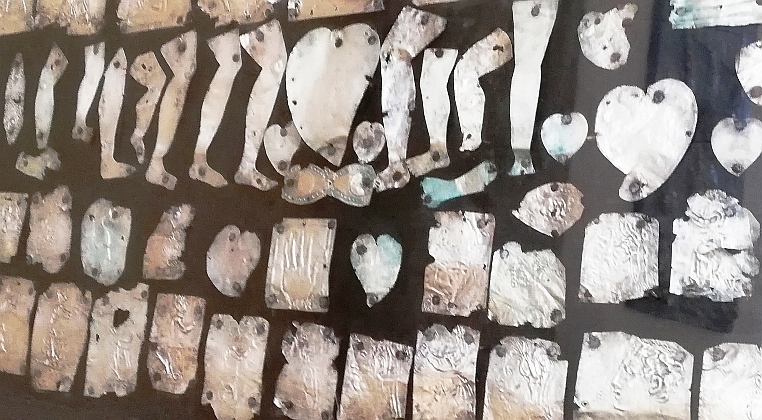

Voting offering by unknown artists. Displayed in a wall-mounted glass cabinet are ninety silver votive offerings of popular devotion, dating back to the 16th-18th centuries, divided into anatomical depictions and figures of praying worshippers. The Ex votos were left as offerings in fulfilment of a vow, or as a sign of gratitude, for the healing of illnesses or wounds. They were restored in 2012. Traditionally, they were placed at the foot of the Crucified Christ.
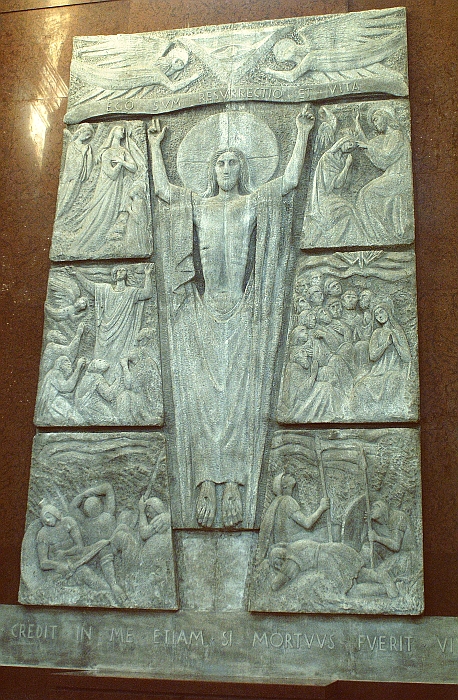

Stone bas-relief for the Sepulchral Chapel of the Bishops Concordia with the Risen Christ and scenes
from the Glorious Mysteries, created in 1964 by sculptor Luigi Strazzabosco, who lived in Padua
between 1895 and 1985. The bas-relief is five metres high and about three metres wide.
Six bishops are buried in it: Fulcherio di Zuccola, consecrated bishop in 1269,
Carlo Fontanini in 1827, Domenico Pio Rossi in 1881, Luigi Paulini in 1919,
Vittorio D'Alessi in 1945, Vittorio De Zanche in 1949 and Sennen Corrà in 1989.
Descrizione...
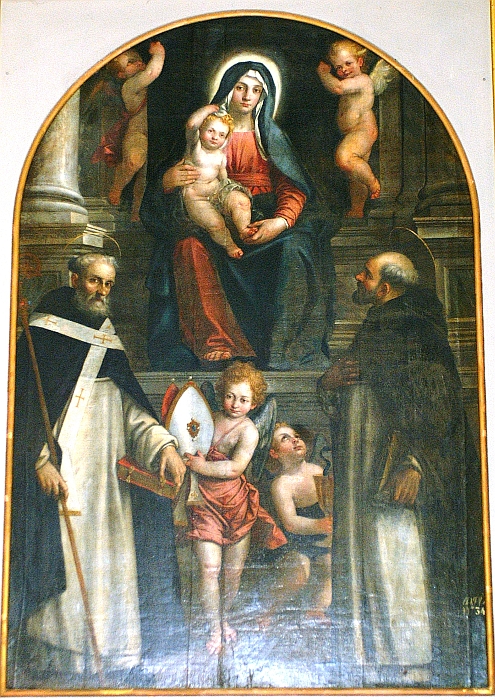
20 'Madonna and Child and Saints', also known as 'Our Lady of Graces', by Pietro Damini (Castelfranco Veneto 1592 - Padua 1631), dated 1631 and measuring 283 x 190 centimetres. It arrived in the Duomo of Portogruaro in 1833 from the state deposit of the former Knight of Malta in Venice and was amount the works of art requisitioned by Napoleon.


21.- "Crucifixion", dated late 16th century, by Palma the Younger, who lived in Venice from 1544 to 1628. This work, measuring 370x470 cm. was commissioned for the old St Andrew's Church.
It is the only altarpiece depicting this subject matter in the churches of Portogruaro.
The direct attribution to Palma is due to the figure of Christ, more dramatic but almost identical to that of the signed altarpiece with the same subject in the Basilica of St. John and St. Paul in Venice.
It was restored in 2009.
Description...
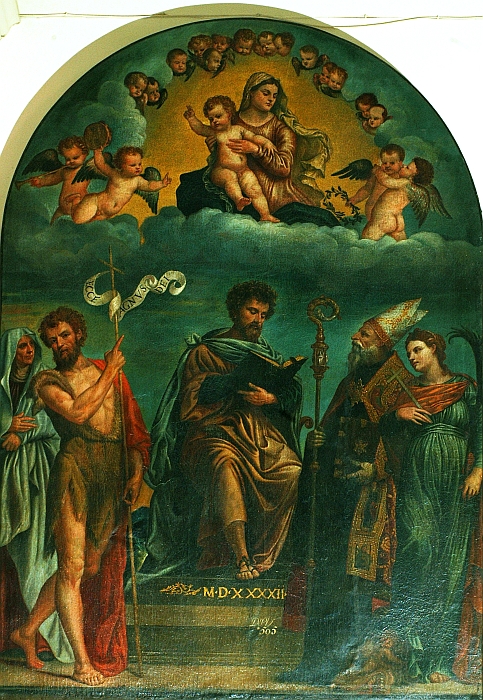

22 "St. Matthias among Saints by Stefano Dall'Arzere, who lived between 1520 and 1573. The work was painted in 1542 and measures 280 by 190 centimetres. On the left of the canvas are St. John the Baptist and St. Anne, on the right St. Benedict and St. Margaret. It arrived in the Duomo of Portogruaro in 1833 from the State Deposit of the former Knights of Malta priory in Venice. It was originally in the Church of St. Matthias in Padua, since demolished, and was among the works of art requisitioned by Napoleon. Description...


23 "Last Supper", by Sante Peranda (Venice 1566-1638), dated 1604 and measuring 148x550 cm. This work was commissioned by the Confraternity of the Holy Sacrament of the old St. Andrew's Church. It bears a strong similarity to the signed painting on the same subject in the Church of St. Martin and St. Rosa in Conegliano. It was restored in 2007.
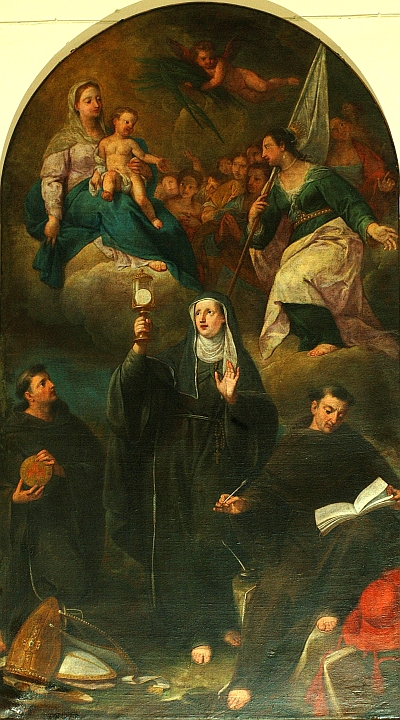

24 "St. Clare between St. Bonaventure and St. Bernardino of Siena. Above, the Blessed Virgin with
Child and St. Ursula in Glory with the Companions of the Martyrdom" by Gregorio Lazzarini
(Venice 1665-Villabona 1730). The work was painted in 1720 and measures 284x156 cm.
This work was commissioned for the Church of St. Francis.
Description by Mons. Arrigo Sedran...
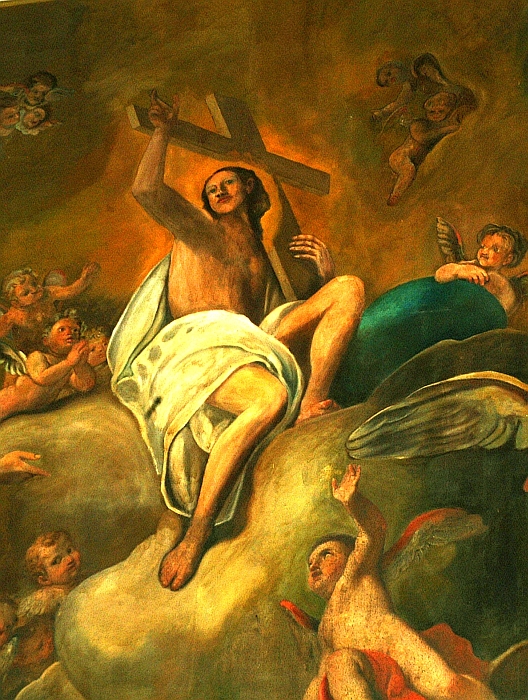

“25 "Christ in Glory among the Angels" 1722, by Gregorio Lazzarini (Venice 1665-Villabona 1730), 450x268 cm. This work was commissioned for the Church of St. Francis. It was located in the Church of St. Agnes from 1830 to 1892.
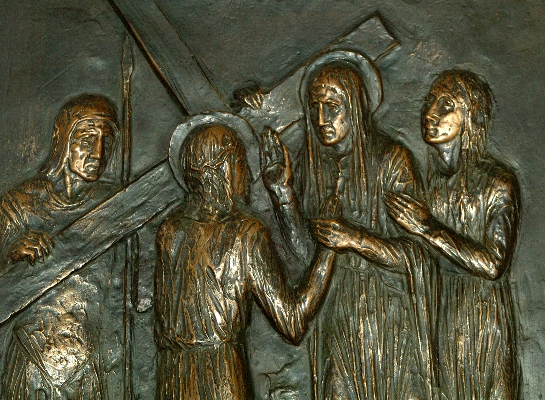
26.- 14 bronze panels with the Stations of the Cross, by Valentino Turchetto, (Portogruaro 1906-1965), dated 1962 and measuring 68x53 cm.
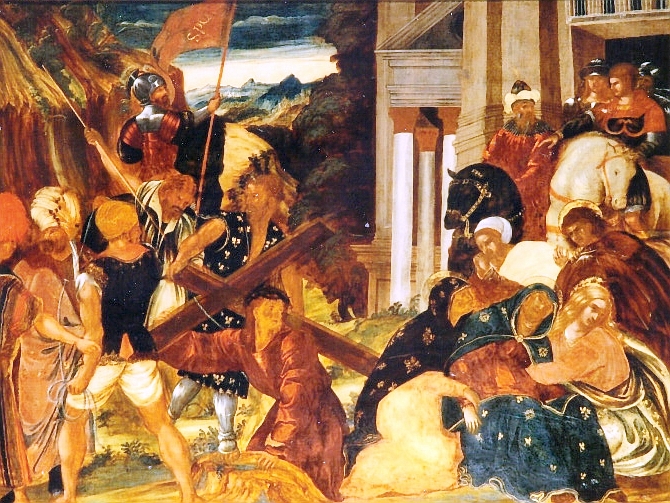
27 "Christ's ascent to Calvary" by an unknown artist, tempera on wood panel, dated 16th century,and measuring 87x112 cm.
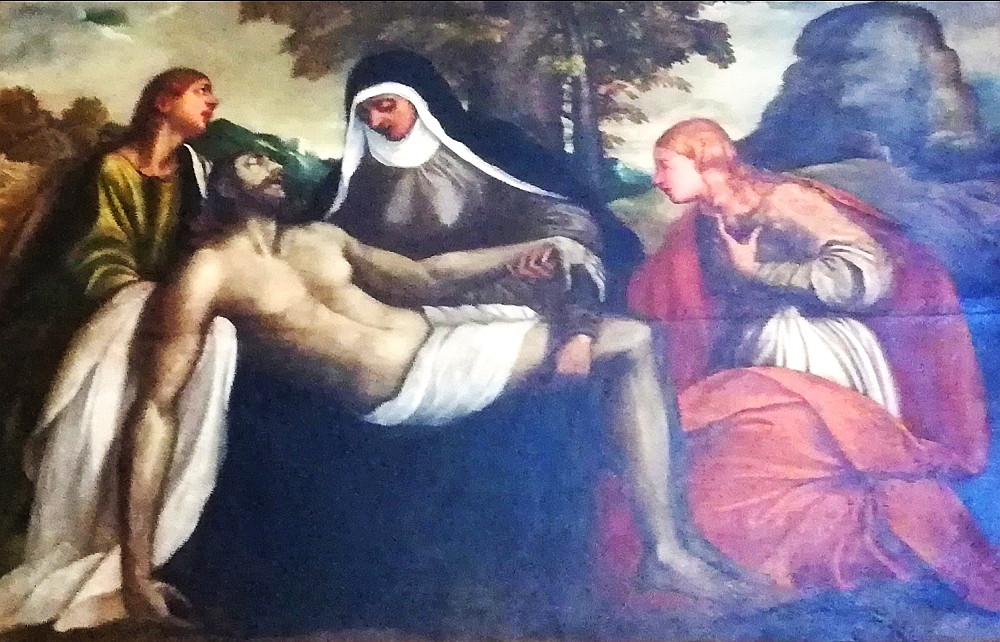
28 "PIETÀ", by an unknown artist from the, Venetian school, dated 16th century, and measuring 135x195 cm.
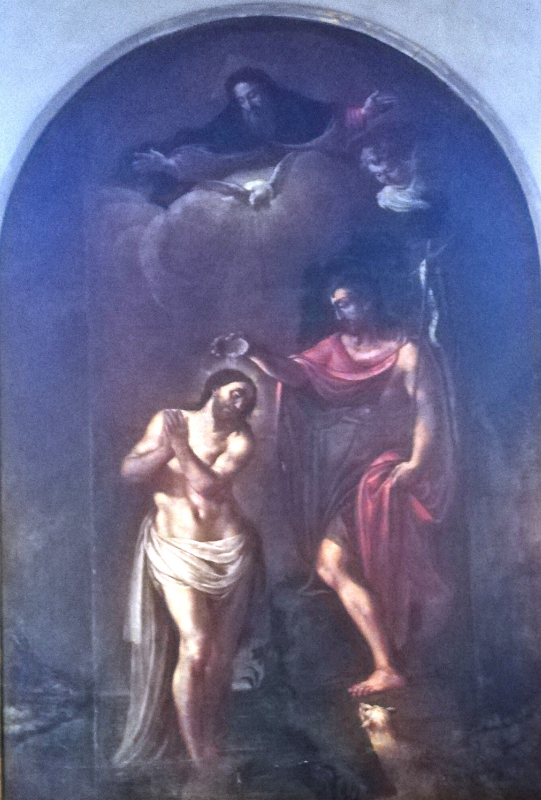

“29 "BAPTISM OF JESUS" by an unknown artist from, 16th-17th century, and measuring 156x212 cm. This painting is located in the small building used as the Baptistery, adjoining the apse. The building is what remains of the demolished Oratory of the Most Holy Body of Christ or of the Holy Spirit, dating back to the second half of the 14th century.
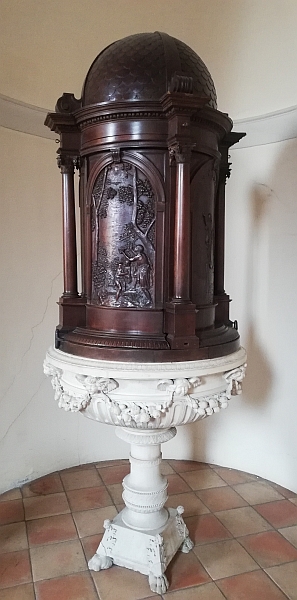
30 BAPTISMAL FONT, 1914 by Giovanni Costantini (1875-1917), in Verona stone and American walnut.
Description...

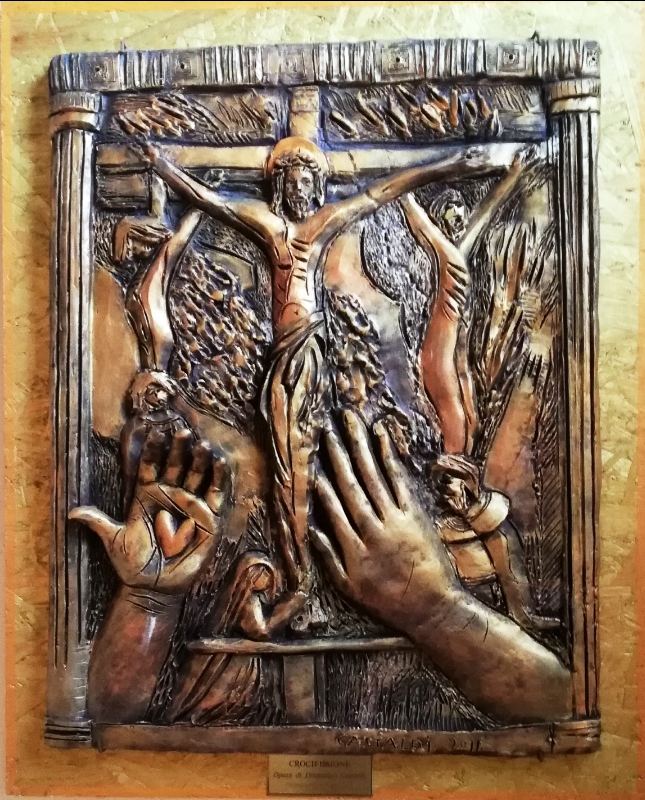
31 "Crucifixion" 2011, Domenico Castaldi (1954), bronze coated terracotta, 80x70 cm.
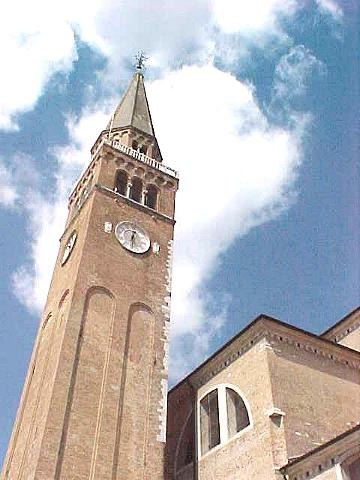

32 The 59-metre bell tower is the ancient civic tower, presumably erected between the 12th and 13th centuries. The conspicuous incline, typical of many bell towers in Venice due to initial subsidence of the foundations, makes it a real tourist attraction. Restoration and repair work is planned. The octagonal spire dates back to 1877-79.
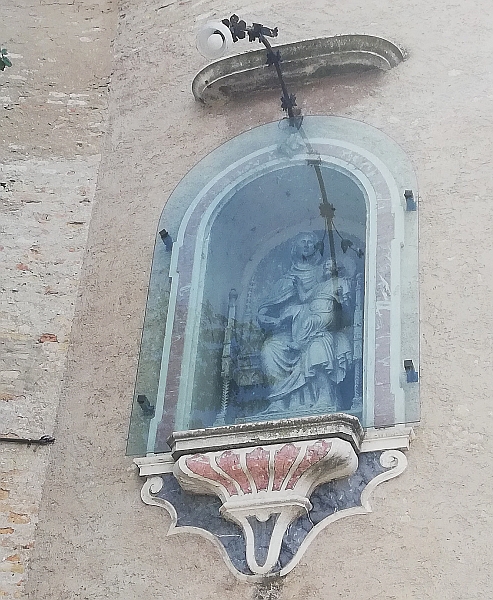
33 "Madonna Enthroned with Child" by an unknown artist. This, stone statue, dating from the 14th century bears similarities with the one commissioned in 1314 for the Church of St. Francis and currently located in the Portogruaro Archaeological Museum
CREDITS:
Concept and realisation:
Ing. Carmelo Amore
Sponsor:
Ing. Carmelo Amore
Contents of the printed guide:
Prof. Emanuela Ortis Alessandrini
Photographic images:
FOTOREPORTER di Vinicio Scortegagna
Html development code revision:
Gianluca Amore
English version editing:
T. C. della Gran Bretagna
Contributions:
dott. Roberto Sandron, Domenico Megliola, dott. Giulio Steccanella germanista
Contacts:







